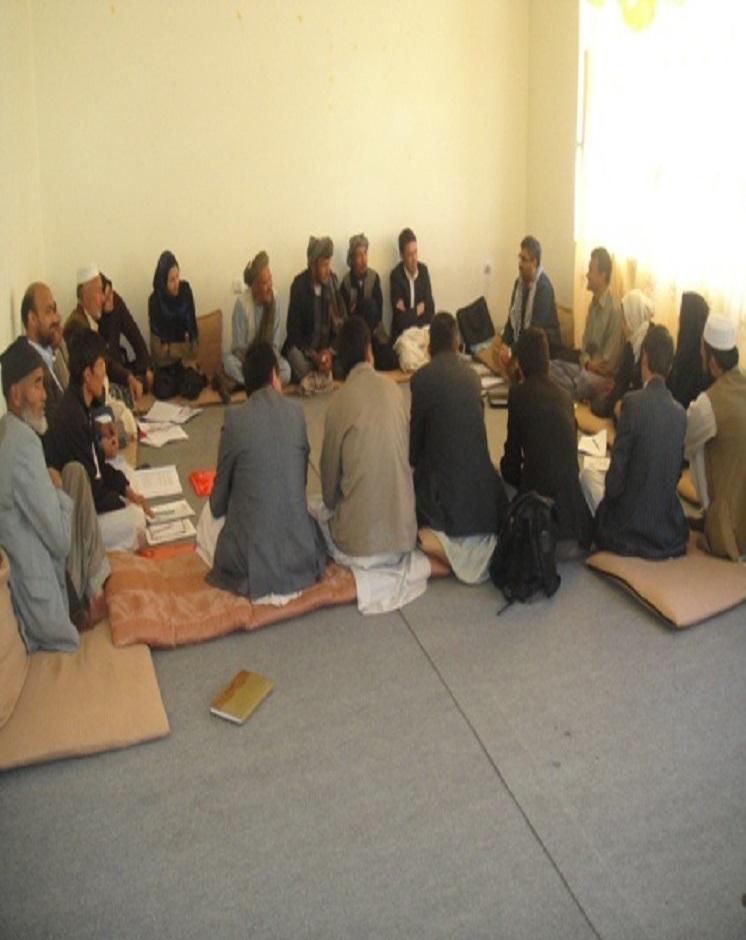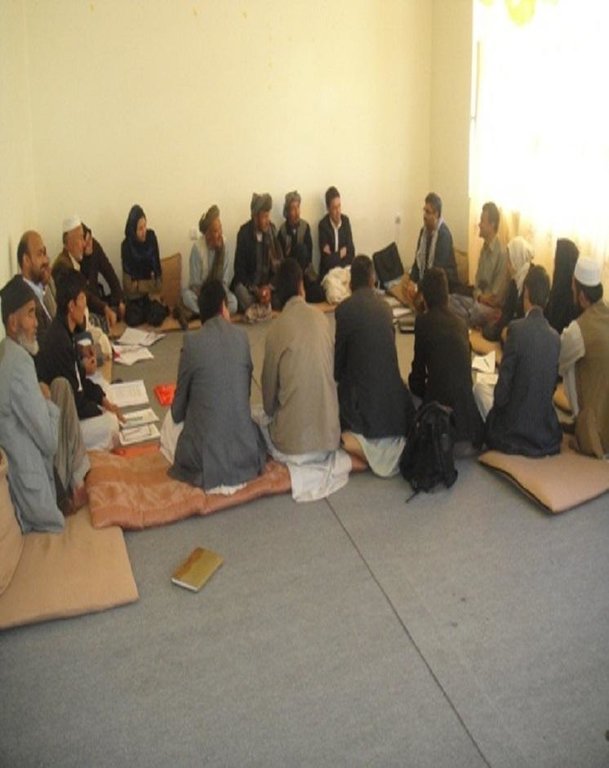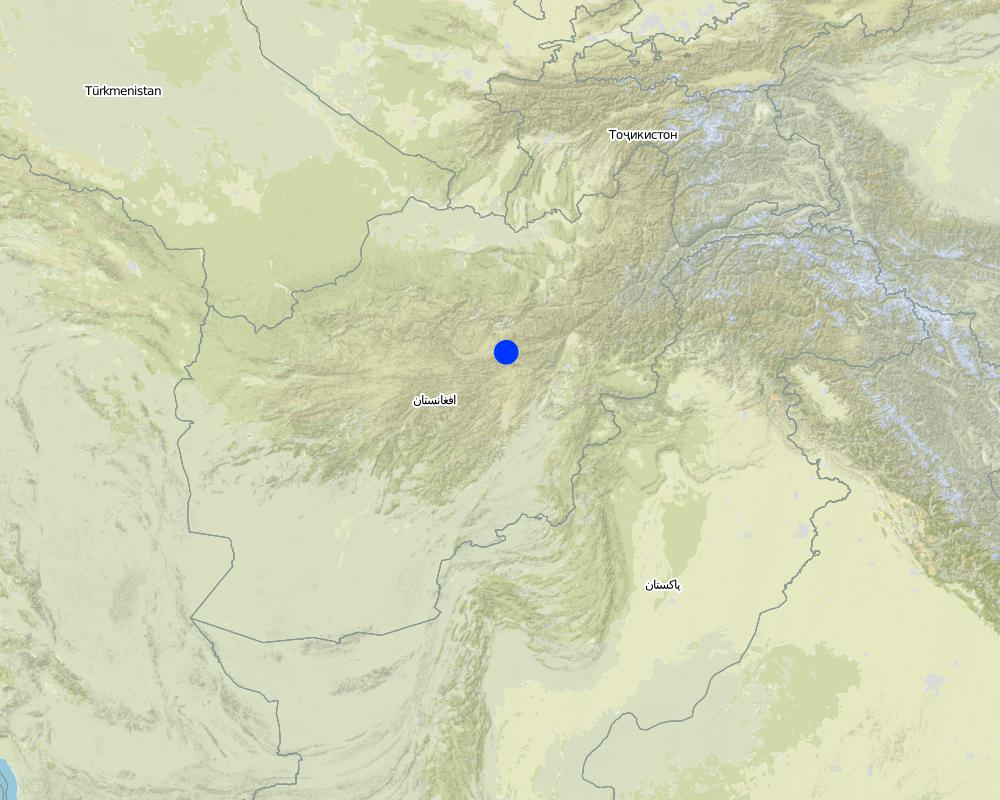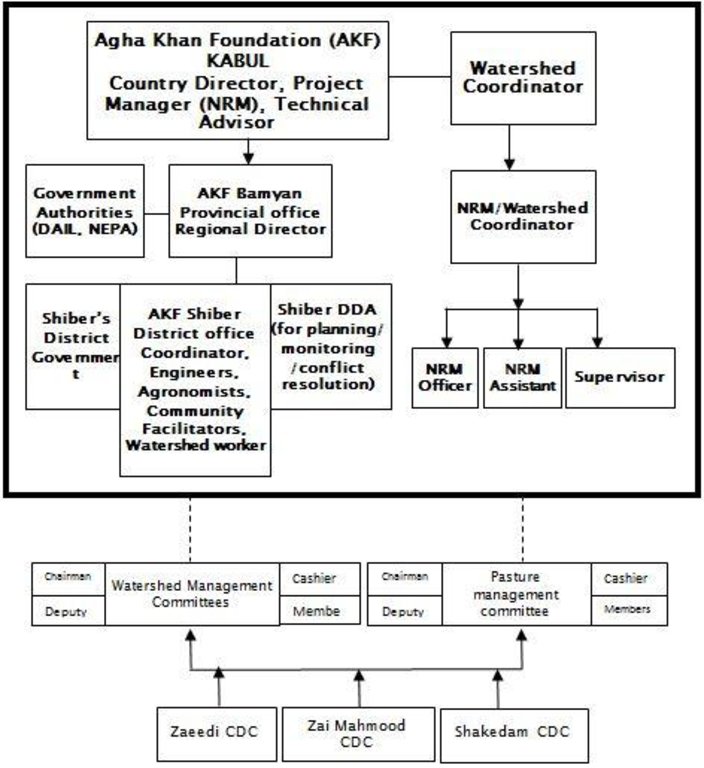Community-based Natural Resource Management [Afghanistan]
- Création :
- Mise à jour :
- Compilateur : Aqila Haidery
- Rédacteur : –
- Examinateurs : Deborah Niggli, Joana Eichenberger
Tanzeem Manabae Tabiee Tawasut Mardum (Dari)
approaches_2542 - Afghanistan
Voir les sections
Développer tout Réduire tout1. Informations générales
1.2 Coordonnées des personnes-ressources et des institutions impliquées dans l'évaluation et la documentation de l'Approche
Spécialiste GDT:
Spécialiste GDT:
Spécialiste GDT:
Ahmadi Ghulam Sakhi
AKF
Afghanistan
Spécialiste GDT:
Jalil M. Altaf
AKF
Afghanistan
Spécialiste GDT:
Hussaini Marzia
Afghanistan
Spécialiste GDT:
Hussaini Baqir
Afghanistan
Spécialiste GDT:
Wafa Jawad
Afghanistan
Spécialiste GDT:
Jawadi Asadullah
Afghanistan
Spécialiste GDT:
Yagoo Alex
Afghanistan
Spécialiste GDT:
Eqbal Muhammad
Afghanistan
Nom du ou des institutions qui ont facilité la documentation/ l'évaluation de l'Approche (si pertinent)
HELVETAS (Swiss Intercooperation)1.3 Conditions relatives à l'utilisation par WOCAT des données documentées
Quand les données ont-elles été compilées (sur le terrain)?
25/08/2015
Le compilateur et la(les) personne(s) ressource(s) acceptent les conditions relatives à l'utilisation par WOCAT des données documentées:
Oui
1.4 Références au(x) questionnaire(s) sur les Technologies de GDT
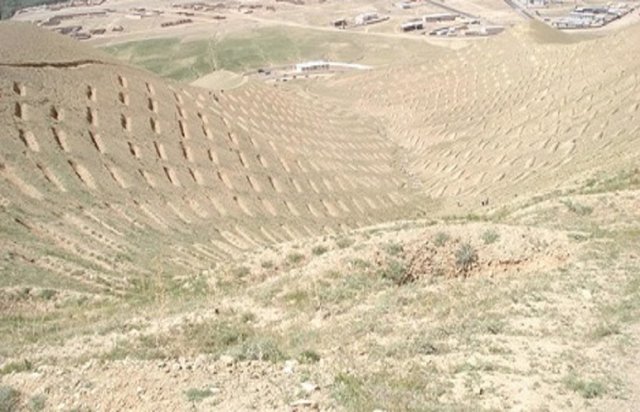
Staggered Contour Trench [Afghanistan]
Earthen trenches with soil bunds built along contours in staggered design
- Compilateur : Aqila Haidery
2. Description de l'Approche de GDT
2.1 Courte description de l'Approche
An approach to community participation in the sustainable management of natural resources
2.2 Description détaillée de l'Approche
Description détaillée de l'Approche:
The main objective of the intervention was to reduce the surface run-off and sediment flow from the selected degraded watershed, with soil and water conservation measures through community participation.
Agha Khan Foundation and representatives from the selected Community Development Councils (CDC) surveyed the area and discussed the main land use problems. On the basis of feasibility surveys, potential SLM technologies were identified and implemented. Contour lines were prepared with the help of an A-frame and lime. Several men from Zai Mahmood village were employed as daily wage workers for the technology implementation works. The land users used their own tools for trench excavation. Each worker excavated on an average one trench per day. The daily wage was 250 AFS/USD.
The project was executed over two years. In addition to the structural measures, training and exposure visits for watershed management committee and pasture committee members, reseeding of more areas, tree plantation campaigns and group-based women vegetable farming were realized. Women were employed for seed collection work with cash for work approach. The area was protected from grazing and shrub cutting pressure. Seeds of different fodder varieties and shrubs were also cultivated.
Since the realization of the project in 2008, soil and vegetation cover has improved, people’s knowledge about soil and water conservation has increased, flash floods have been controlled and discharge in the spring located below the watershed has increased by about 40%. AKF continues to support the target communities with community development and institution building. The water-shed work is sustained by a watershed and pasture management committee appointed by the people from three respective CDCs.
The Community-Based Natural Resource Management approach is documented by Sustainable Land Management Project implemented/HELVETAS Swiss Intercooperation which is funded by Swiss Agency for Development and Cooperation with close support and cooperation of the Agha Khan Foundation (AKF).
The watershed project was funded by AusAID. The Aga Khan Foundation (AKF) facilitated the implementation by the community. The project was implemented in Zai Mahmood mountain slope area in Zai Mahmood village, Shiber district, Bamyan Province. The village, located downstream from the site, experienced problems such as excessive surface runoff/flash floods, snow avalanches, soil erosion, lack of drinking water, lack of soil moisture at the site.
2.3 Photos de l'approche
2.5 Pays/ région/ lieux où l'Approche a été appliquée
Pays:
Afghanistan
Région/ Etat/ Province:
Zai Mahmood village
Autres spécifications du lieu :
Bamyan center, Afghanistan
Map
×2.6 Dates de début et de fin de l'Approche
Indiquez l'année de démarrage:
2008
2.7 Type d'Approche
- fondé sur un projet/ programme
2.8 Principaux objectifs de l'Approche
The Approach focused mainly on SLM with other activities (Disaster Risk Reduction, Pasture Improvement, Gender Equity, Income Generation)
Strengthen the capacity (organizational and technical), of the community to: restore their degraded lands, demonstrate multi-purpose soil and water conservation measures, reduce floods and snow avalanches, improve pastures, improve gender equity and the involvement of social disadvantaged groups, employment and income generation
The SLM Approach addressed the following problems: Lack of knowledge in terms of sustainable watershed management; poverty; drought; floods and avalanches
2.9 Conditions favorisant ou entravant la mise en œuvre de la(des) Technologie(s) appliquée(s) sous l'Approche
normes et valeurs sociales/ culturelles/ religieuses
- entrave
Community-based management capacity was weak
Treatment through the SLM Approach: CDCs capacities were enhanced
disponibilité/ accès aux ressources et services financiers
- entrave
Community’s low economy
Treatment through the SLM Approach: AKF provided financial support; also there were contributions from the participating community
cadre institutionnel
- entrave
Lack of organizational structures
Treatment through the SLM Approach: Watershed and pasture management committees formed
connaissances sur la GDT, accès aux supports techniques
- entrave
Lack of technical awareness
Treatment through the SLM Approach: AKF provided technical support
3. Participation et rôles des parties prenantes impliquées dans l'Approche
3.1 Parties prenantes impliquées dans l'Approche et rôles
- exploitants locaux des terres / communautés locales
- organisations communautaires
3.2 Participation des exploitants locaux des terres/ communautés locales aux différentes phases de l'Approche
| Participation des exploitants locaux des terres/ communautés locales | Spécifiez qui était impliqué et décrivez les activités | |
|---|---|---|
| initiation/ motivation | interactive | Meetings and Workshops for men and women |
| planification | interactive | With CDC members, mainly men for watershed works |
| mise en œuvre | soutien extérieur | Interactive, Cash for work, Contributions from communities as well |
| suivi/ évaluation | interactive | Ad hoc observations |
| Research | interactive | Analyzing technology performance and making adjustments if required |
3.3 Diagramme/ organigramme (si disponible)
Description:
The organization structure of the NRM project implemented in Zai Mahmood village, Shiber district, Bamyan, Afganistan
Auteur:
Agha Khan Foundation (AKF)
3.4 Prises de décision pour la sélection de la Technologie/ des Technologies
Indiquez qui a décidé de la sélection de la Technologie/ des Technologies à mettre en œuvre:
- principalement les spécialistes de la GDT, après consultation des exploitants des terres
Expliquez:
AKF conducted awareness workshops before project implementation.
Decisions on the method of implementing the SLM Technology were made by mainly by land users supported by SLM specialists. land users implemented the technology after receiving guidelines from SLM specialists.
4. Soutien technique, renforcement des capacités et gestion des connaissances
4.1 Renforcement des capacités/ formation
Une formation a-t-elle été dispensée aux exploitants des terres/ autres parties prenantes?
Oui
Spécifiez qui a été formé:
- exploitants des terres
- personnels/ conseillers de terrain
Formats de la formation:
- sur le tas
- entre agriculteurs (d'exploitants à exploitants)
- zones de démonstration
- réunions publiques
Thèmes abordés:
Vegetable farming for women; soil and water conservation; watershed management; pasture management. Training was mainly on-the-job, and awareness was raised through public meetings, site visits and demonstrations.
4.2 Service de conseils
Les exploitants des terres ont-ils accès à un service de conseils?
Oui
Décrivez/ commentez:
On-site visits by DAIL (Department of Agriculture, Irrigation and Livestock; Key elements: Pasture management, Site selection
Advisory service is quite adequate to ensure the continuation of land conservation activities; The government or other advisory service is quite adequate to ensure the continuation of land conservation activities although the staff turnover rate in government sector is high. DAIL Bamyan office has the technical capacity but not adequate financial resources.
4.3 Renforcement des institutions (développement organisationnel)
Des institutions ont elles été mises en place ou renforcées par le biais de l'Approche?
- oui, beaucoup
Spécifiez à quel(s) niveau(x), ces institutions ont été renforcées ou mises en place:
- local
Précisez le type de soutien:
- financier
- renforcement des capacités/ formation
Donnez plus de détails:
CDCs and District Development Assembly (DDA) in terms of financial and capacity building of participating
4.4 Suivi et évaluation
Le suivi et l'évaluation font ils partie de l'Approche? :
Oui
Commentaires:
bio-physical aspects were regular monitored by project staff, land users through measurements; indicators: Biomass before and after
technical aspects were ad hoc monitored by project staff, land users through observations; indicators: growth of saplings, shrubs and fodder grasses (alfalfa)
socio-cultural aspects were ad hoc monitored by project staff, land users through measurements; indicators: Water availablity, food security, income
economic / production aspects were regular monitored by project staff through measurements; indicators: fodder production, income
area treated aspects were ad hoc monitored by project staff through measurements; indicators: areas where technology was applied
no. of land users involved aspects were regular monitored by project staff, land users through measurements; indicators: CDCs and men and women involved
management of Approach aspects were regular monitored by project staff, government, land users through observations; indicators: area protected or not
There were few changes in the Approach as a result of monitoring and evaluation: Women has given some more chances for the participation but still there is long way to go. There were some technology refinements and adjustments in project management.
4.5 Recherche
La recherche a-t-elle fait partie intégrante de l’Approche?
Oui
Spécifiez les thèmes:
- sociologie
- économie/ marketing
- écologie
- technologie
Donnez plus de détails et indiquez qui a mené ces recherches:
However there are no publications to verify that. Research was carried out on-farm
5. Financement et soutien matériel externe
5.1 Budget annuel de la composante GDT de l'Approche
Si le budget annuel précis n'est pas connu, indiquez une fourchette:
- 10 000-100 000
Commentez (par ex. principales sources de financement/ principaux bailleurs de fonds):
Approach costs were met by the following donors: international: 50.0%; national non-government: 30.0%; local community / land user(s): 20.0%
5.4 Crédits
Des crédits ont-ils été alloués à travers l'Approche pour les activités de GDT?
Non
5.5 Autres incitations ou instruments
D'autres incitations ou instruments ont-ils été utilisés pour promouvoir la mise en œuvre des Technologies de GDT?
Non
6. Analyses d'impact et conclusions
6.1 Impacts de l'Approche
Est-ce que l'Approche a aidé les exploitants des terres à mettre en œuvre et entretenir les Technologies de GDT?
- Non
- Oui, un peu
- Oui, modérément
- Oui, beaucoup
Increased water and soil quality with more vegetation and reduction in floods
Est-ce que l'Approche a autonomisé les groupes socialement et économiquement défavorisés?
- Non
- Oui, un peu
- Oui, modérément
- Oui, beaucoup
Through increased decision-making powers about natural resources by poor and marginalized members of the community.
Did other land users / projects adopt the Approach?
- Non
- Oui, un peu
- Oui, modérément
- Oui, beaucoup
There is no spontaneous adoption.
Did the Approach lead to improved livelihoods / human well-being?
- Non
- Oui, un peu
- Oui, modérément
- Oui, beaucoup
Cash for work improved income of some families, flash floods reduced, spring discharge increased, natural assets preserved.
Did the Approach help to alleviate poverty?
- Non
- Oui, un peu
- Oui, modérément
- Oui, beaucoup
By increasing water for agriculture and feed for livestock
6.2 Principale motivation des exploitants des terres pour mettre en œuvre la GDT
6.3 Durabilité des activités de l'Approche
Les exploitants des terres peuvent-ils poursuivre ce qui a été mis en œuvre par le biais de l'Approche (sans soutien extérieur)?
- incertain
Si non ou incertain, spécifiez et commentez:
Although the participating CDCs indicate that they will continue to manage the watershed properly
6.4 Points forts/ avantages de l'Approche
| Points forts/ avantages/ possibilités du point de vue du compilateur ou d'une autre personne ressource clé |
|---|
| Increase in vegetation cover |
| People knowledge regarding SWC improved |
| Increase in spring water |
| Flash flood controlled |
| Watershed and pasture management committees formed |
6.5 Faiblesses/ inconvénients de l'Approche et moyens de les surmonter
| Faiblesses/ inconvénients/ risques du point de vue du compilateur ou d'une autre personne ressource clé | Comment peuvent-ils être surmontés? |
|---|---|
|
Disturbance in NRM / soil disturbance |
Minimize the soil disturbance, and compact the excavated soil |
| Increase in mice | Compact the excavated soil, other control measures |
| Plant growth is slow due to high elevation | Choose adaptable species |
| No watershed benefit sharing mechanism in place | Benefit mechanism be developed in a participatory way and agreed by the land users and other stakeholders |
7. Références et liens
7.1 Méthodes/ sources d'information
- visites de terrain, enquêtes sur le terrain
- interviews/entretiens avec les exploitants des terres
Liens et modules
Développer tout Réduire toutLiens

Staggered Contour Trench [Afghanistan]
Earthen trenches with soil bunds built along contours in staggered design
- Compilateur : Aqila Haidery
Modules
Aucun module trouvé


